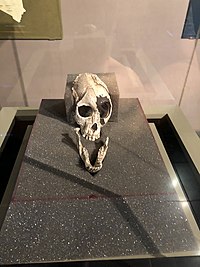Ekembo
| Ekembo Temporal range:Miocene,
| |
|---|---|

| |
| Ekembo nyanzaeskeleton (formerlyProconsul nyanzae) | |
| Scientific classification | |
| Domain: | Eukaryota |
| Kingdom: | Animalia |
| Phylum: | Chordata |
| Class: | Mammalia |
| Order: | Primates |
| Suborder: | Haplorhini |
| Infraorder: | Simiiformes |
| Parvorder: | Catarrhini |
| Superfamily: | Hominoidea |
| Genus: | †Ekembo McNultyet al.,2015 |
| Species | |
Ekembois an early ape (hominoid)genusfound in 17- to 20-million-year-old sediments from theMioceneepoch. Specimens have been found at sites around the ancient Kisingiri volcano inKenyaonRusinga IslandandMfangano IslandinLake Victoria.The nameEkemboisSubafor "ape"or"monkey".[1]
To account for substantial morphological variation in the genusProconsul,two species,P. nyanzaeandP. heseloni,were placed in the new genusEkembo.Ekembois one of the earliest ape (Hominoids), after having diverged from the old world monkeys. TheDendropithecidaeappear to be sister toEkembo.Ekembowas found to be paraphyletic with respect toProconsuland the more advanced Hominoidea.[2][3]
Description[edit]
Ekembois distinguished from other early Miocene catarrhines on the basis of dental and mandibular morphology. ThemolarsofEkemboare more rounded or bunodont than those ofProconsuland thecanine teethtaper to a point while those ofProconsulare more "blade-like".E. heseloniis medium-sized whileE. nyanzaeis larger. BothE. nyanzaeandE. heseloniare moderatelysexually dimorphic.

References[edit]
- ^Kieran P. McNulty, David R. Begun, Jay Kelley, Fredrick K. Manthi and Emma N. Mbua (2015). "A systematic revision of Proconsul with the description of a new genus of early Miocene hominoid". Journal of Human Evolution. 84: 42-61. doi:10.1016/j.jhevol.2015.03.009.
- ^Rossie, James B.; Hill, Andrew (2018-12-01). "A new species of Simiolus from the middle Miocene of the Tugen Hills, Kenya".Journal of Human Evolution.125:50–58.Bibcode:2018JHumE.125...50R.doi:10.1016/j.jhevol.2018.09.002.ISSN0047-2484.PMID30502897.S2CID54625375.
- ^Rasmussen, D. Tab; Friscia, Anthony R.; Gutierrez, Mercedes; Kappelman, John; Miller, Ellen R.; Muteti, Samuel; Reynoso, Dawn; Rossie, James B.; Spell, Terry L. (2019-03-11)."Primitive Old World monkey from the earliest Miocene of Kenya and the evolution of cercopithecoid bilophodonty".Proceedings of the National Academy of Sciences.116(13): 6051–6056.Bibcode:2019PNAS..116.6051R.doi:10.1073/pnas.1815423116.ISSN0027-8424.PMC6442627.PMID30858323.




